From Ragtime to Jazz: Music during WWI

During World War One, the popular cultures were changed and created due to the special war period people were experiencing and the mixed culture environment. As one of the most approachable art forms, music also experienced a fast transition during this period of cultural transition. In America, ragtime is the dominated music genre in pre-war period and during war. While Jazz, from the same African American root with ragtime, was gradually in vague during the war, and replaced ragtime as the most popular type of music.
Ragtime became popular in the 1890s, and reigned during the late 1910s. The unusual displacing of the beat from its regular course of meter, which is called syncopation, caused excitement among the youth, bringing them the feeling of propulsion, swing, and a musical looseness. Ragtime is also a popular music for dancing at the beginning of 20th century. People found the syncopated rhythm of ragtime music from rural South and Midwest quite fit their two-step dance. However, musicians in New Orleans during the early 1900s innovated novelty piano style, such as stride piano, based on traits of ragtime, which was seen as the start of jazz. Around 1917, ragtime’s popularity faded as jazz came to the stage center.
The Entertainer by Scott Joplin (1902)
Music culture in America also had big influence to European musicians during wartime. The introducing of vogue ragtime already started since pre-war time. The catchy syncopation of ragtime fascinated the ballroom dancers and also musicians like Debussy and Stravinsky, who wrote ragtime compositions by that time. Jazz was later transported to Europe by African American regimental bands.
Among the early African American musicians in Europe, James Reese Europe and Noble Sissle are the most renowned songwriters helped to spread Jazz culture to Europe audience. European bands by that time consisted of European, Puerto Rican and African American musicians, which also contributes to undo racial segregation by the shared appreciation to Jazz. In diary of Charles Hamilton Houston, a First Lieutenant in the United States Infantry who serviced in France in WWI and later became a prominent African American human rights lawyer, he also mentioned the wide love of Jazz in France:
"Paris is taken away with [Jazz] and our style of dancing. The girls come after the boys in taxis and beg them to go to the dance. Colored boys are all the go."
James Reese Europe and his 369th Regiment military band
Reference:
http://www.classical-music.com/article/what-was-impact-world-war-one-music
https://rememberingwwi.villanova.edu/popular-culture/
https://www.loc.gov/item/ihas.200035811/
https://en.wikipedia.org/wiki/Charles_Hamilton_Houston#Career
100% of the SBD rewards from this #explore1918 post will support the Philadelphia History Initiative @phillyhistory. This crypto-experiment conducted by graduate courses at Temple University's Center for Public History and MLA Program, is exploring history and empowering education. Click here to learn more.
https://steemit.com/@a-0-0
Congratulations @landy-yinan! You have completed some achievement on Steemit and have been rewarded with new badge(s) :
Click on any badge to view your own Board of Honor on SteemitBoard.
To support your work, I also upvoted your post!
For more information about SteemitBoard, click here
If you no longer want to receive notifications, reply to this comment with the word
STOPDo not miss the last announcement from @steemitboard!